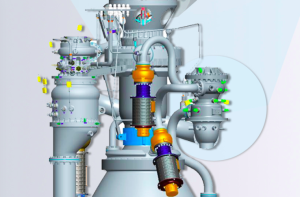 NASA has tested a 3D-printed rocket engine turbopump which is described as “one of the most complex, 3D-printed rocket engine parts ever made.”
NASA has tested a 3D-printed rocket engine turbopump which is described as “one of the most complex, 3D-printed rocket engine parts ever made.”
The pump was designed by the engineers of Marshall Space Flight Center in Huntsville, Alabama, and outside vendors. It’s capable of operating at more than 90,000 revolutions per minute and generating over 2,000 bhp (1,500 kW) as it pumps 1,200 gal (4,500 l) of cryogenic liquid hydrogen per minute. According to NASA, 3D printing allows the pump to use 45 percent fewer parts than conventional designs.
The pump was subjected to 15 full-power tests, which were enough to feed an upper stage rocket engine capable of generating 35,000 lb of thrust. During the tests, the turbopump delivered the fuel at a temperature of -400º F (-240º C), which then burned at over 6,000º F (3,315º C).
NASA regards 3D-printing as a way to manufacture spacecraft components more economically, as well as carry out manned deep space missions without the need to carry enormous stores of spare parts.
The method used to produce the turbopump was laser additive printing. In this process, a powder of metal alloy is spread in a thin layer by the printing machine. A computer-controlled laser then fuses the powder into a cross section of the engine component. The machine spreads a second layer of powder and the process repeats until the component is complete. The excess powder is then removed as are any temporary supports printed to hold the component together during printing, then it’s hardened, polished, and assembled.
NASA says that the engine design and test data are open to American companies working on future space engines.



